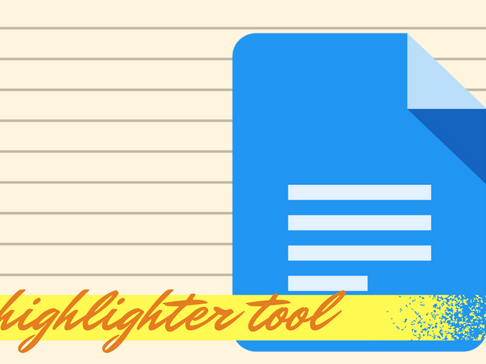The Highlight Tool is a simple but powerful Google Docs Add-On that teachers can use to provide feedback on student written work. The key benefit of the Highlight Tool is the ability to create a customized series of highlighters on different topics that can also be organized in a library and shared.
Those familiar with the highlight feature available in Google Docs know that you can select a word(s), a sentence, a paragraph or more, and highlight it a particular color. With the Highlight Tool Add-On, you can not only highlight, you can also create, label, and organize sets of customized highlighters that help facilitate a wide range of instructive feedback.
To get started, the Highlight Tool is available via the “Add-On” menu in in a Google Doc. Look under “Add-On” for “Get Add-Ons,” click it, navigate to the Highlight Tool, and install it. Once installed, the Highlight Tool is available for use in any Google Doc.
To create a set of color-coded highlighters, select “Highlighter Library” and give your set of highlighters a name. Then assign a label to a color. For instance, if you want to highlight punctuation mistakes purple, type “punctuation” and select the color purple. Continue to add text and colors and then save your set of highlighters. Later on, you can always click “Create Highlighters” to add more highlighters to your set, as shown below.
You can even share your highlighters by exporting the highlighted text to a separate document by sequence or by color. In this way, a teacher might share a customized series of highlighters with students so all understand the highlight color designations.
Some of the best uses of the Highlight Tool include feedback on student essays, reports, and stories and for categorizing themes or ideas. For instance, a high school English teacher might use the Highlight Tool to create a set of highlighters labeled “Grammar and Conventions” to provide grammar feedback on student essays. As pictured above, a teacher could create different color-coded grammar highlighters — yellow for Dangling Modifiers, orange for Passive Voice, red for Run-On Sentences, etc. — to draw attention to grammar issues and stylistic conventions in student essays.
A teacher might go on to create another set of highlighters, perhaps labeled “Comma Usage” with specific issues — say, yellow for “Introductory Phrase,” orange for “Items in List,” and the like. A history teacher might create a set of highlighters around aspects of historical writing and a science teacher might create a set of highlighters related to Lab Report feedback. Students might create their own highlighters to highlight and organize terms they are unfamiliar with or as a reminder to study these items.
One of the benefits of color-coded highlighter feedback is that students can receive specific teacher feedback without the teacher having to take considerable time to write complete sentences explanations (often over and over again to different students). So, instead of a teacher writing “This is a vague phrase which needs to be revised and include more specific language,” the teacher could simply highlight the phrase in question and use the combination of color and label in the Highlight Tool to provide quick feedback. The longer a student waits for feedback the less useful it is, so the Highlight Tool is very helpful in speeding up the feedback process.
Finally, a teacher can use the Highlight Tool to shift the responsibility of editing to the student by prompting the student to reflect on his grammar or stylistic conventions and make an improvement to the essay. Students taking greater responsibility over their writing process is a worthwhile goal and the Highlight Tool Add-On is a great vehicle to helps students and teachers to do just that!



